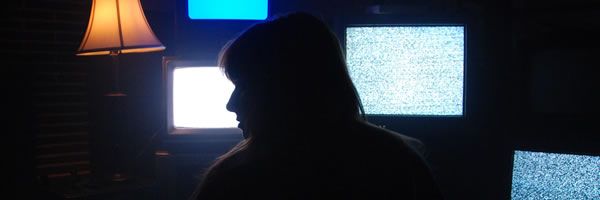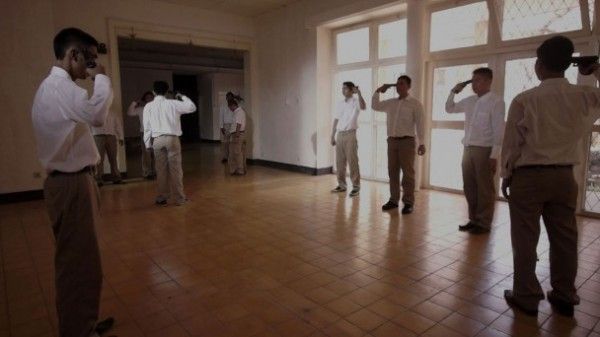The horror anthology sequel V/H/S/2 is a mixed bag, both in terms of the horror shorts it presents and the identity the franchise is trying to acquire. Arriving a year after its predecessor, it's clear that V/H/S/2 is meant to be the first of what should be an ongoing series where fan-favorite indie directors step behind the camera to deliver a horror short. The sequel attempts to reduce the flabbier aspects of the original, but it also feels more standardized and therefore less exciting. Additionally, two of the four shorts come across as underdeveloped or rushed. But the ones that work are worth the price of admission, and make the strongest case for the existence of a V/H/S franchise.
The first V/H/S wasted time following a group of jerks before finally getting them to a spooky house where they watched demented found-footage movies hidden amongst endless stacks of VHS tapes. V/H/S/2 moves much faster with a couple of private investigators quickly arrive at a house (I'm not sure if it's the same one from the original) looking for a missing college student. Once inside the house, they come across stacks of tapes and televisions. One of the investigators, Ayesha (Kelsy Abbott), begins watching the tapes for clues about the missing student's disappearance, and comes across disturbing stories involving ghosts, zombies, cults, and aliens.
V/H/S/2 hardly spends any time on the framing device (Simon Barrett's "Tape 49"), so the overarching short fails to get any scares, especially since the investigators are fairly unlikable folks who extort their clients. Instead, it's the perfunctory introduction to get straight to the other shorts, and I'm wondering how future filmmakers will handle this task if there are future installments. I'm not sure how many times people can enter a spooky house at night and come across the VHS collection before the premise requires some kind of mythos.
As for the shorts Ayesha watches, the first segment, Adam Wingard's "Clinical Trials", is an underdeveloped idea about a man who gets a technologically advanced prosthetic eye (the recording device) that comes with the unintended consequence that he begins seeing ghosts. That's about the end of it. The ghosts aren't memorable, and there's no personal connection between the man and the spirits, so it's pretty much all jump scares and loud noises. "Clinical Trials" is a conceit with the thinnest possible story imaginable.
The next short, Gregg Hale and Eduardo Sanchez' "A Ride in the Park", is far more entertaining. A man puts on a helmet-mounted camera for his bike ride through the forest, and gets turned into a zombie along the way. While it's not the first movie to use a zombie as the protagonist, having a short from a zombie's POV is inspired, but it's also an idea that works far better for a short than a feature. "A Ride in the Park" helps put us in the mind of a mindless zombie, and the result is damn entertaining.
Then we get to the short that will probably be better than most features this year: Gareth Evans and Timo Tjahjanto's "Safe Haven". The story revolves around a group of TV journalists who investigate a cult under the pretense of doing a straight interview with its leader, but wear hidden cameras to try and get the true story. The short is absolutely horrifying because it takes time to build characters, define the setting, and suck us in completely. Just when you think "Safe Haven" can't get any crazier, it finds a new way to go bonkers. Evans and Tjahjanto expertly let us know what cameras are available, where they are in relation to each other, and so the most ambitious of the short films also turns out to be the best.
"Safe Haven" should have been the last short because it's almost impossible to top it. Instead, the final short (before wrapping around to finish out "Tape 49") is Jason Eisener's "Alien Abduction Slumber Party", which is probably the weakest story outside of the framing device. The short just feels rushed and poorly defined as a camera is strapped to the family dog as a big sister tries to party with her friends while her parents are away, but her little brother and his buddies keep using pranks to bust up her fun. Then aliens come along. The silly dialogue Eisener featured in his film Hobo with a Shotgun makes an appearance, but "Slumber Party" just comes off as a bad fit all around. There's no reason for what's happening to be taped, the method of recording feels silly, and there's absolutely no room for character or plot. The short's inclusion feels like filler, which isn't a good sign considering that there are fewer segments in the latest anthology.
There's also a bit of an identity problem with V/H/S/2. The first film was far more attached to the idea of short films that were not only found-footage, but would be undiscovered for a reason. They're stories that only affect a few people. By comparison, three of the four shorts in V/H/S/2 involve some doomsday scenario that for some reason has escaped the attention of the rest of the world. A restriction of the anthology's parameters has been relaxed, and if the result is "Safe Haven" or "A Ride in the Park", I can suspend my disbelief.
The real challenge seems to be one that faces any other film, whether it's feature-length or a short: a good story. "Tape 49", "Clinical Trials", and "Alien Abduction Slumber Party" only go so far as spooky things happening in a found-footage format. "A Ride in the Park" and "Safe Haven" take the found footage conceit and see it not as a restriction or a requirement but an opportunity. If all directors have the time and put in as much effort as the directors of those shorts, then there's hope for the V/H/S franchise.
Rating: B-
Click here for all of our SXSW 2013 coverage. Click on the links below for my other reviews:


